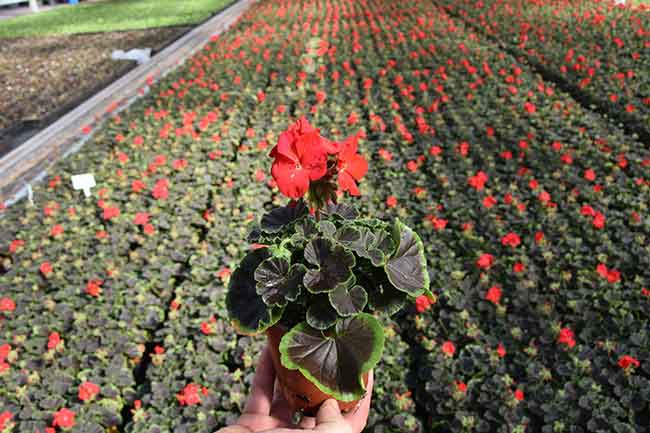
Features
Business
Management
Looking Ahead to 2025
Is your operation on track to thrive in the coming decade? Do you have the necessary investment and marketing plans in place to deal with changing demographics?
August 10, 2016 By Melhem Sawaya
 There is always a market for quality.
There is always a market for quality. September 2016 – For people who want nothing to do with gambling, I wonder why they are living in a casino. Greenhouse operators are farmers and they like to take a gamble. They take big risks every time a decision is put into action.
Even though this is the nature of the business, many steps can be taken to increase the odds of success.
Throughout my 38 years in the greenhouse industry I have seen many successful operations and some disasters and many in between. The
degree of success always runs hand-in-hand with the foresightedness of the owner, operator or manager; this is in addition to the ability and willingness for planning.
Here are, generally speaking, the basic steps in the planning process:
Set goals. Identify specific objectives. This should include a detailed overview of each goal, the reason for the selection and the anticipated outcomes.
Objectives should be defined in qualitative or quantitative terms.
And the most important thing is to discuss it and share it with all the people that are going to be involved in making any of these goals a reality.
FINANCIAL AND HUMAN RESOURCES
Each goal should have financial and human resources identified. An example of this would be of setting a goal of increasing profit margins by 10 per cent. This would require an outline of the steps necessary to accomplish it.
The first step would be to determine the costs of production, shipping and
average selling price of every item. This will require the input of many of your staff and then assigning the job to one person in-house or someone hired to accumulate all the information so decisions can be made.
- Establish goal-related tasks. Each goal should have tasks associated with its achievement.
- Define these tasks, and prioritize them in a chronological order so there is no interruption in the flow towards the goal.
- Establish timelines. Set realistic dates for specific tasks to be completed.
- Be flexible. Evaluate the different tasks as they progress and make adjustments as things gets to be clearer.
This is a general guideline on how to establish a plan. Every plan dictates specific tasks but the general format does not change much although the approach does.
Here are aspects to be considered in planning to thrive in the near future … 2025 and beyond.
The reality is that we are in an industry that is not growing as much as production is, so as a greenhouse operation we must decide where we want to be in the future and start working on meeting these targets.
Be sure to make a plan and get everyone who will be involved on board with the project.
THE GOOD, THE BAD AND THE UGLY
Look into the past five to 10 to 20 years and analyze how your operation progressed, flattened out or regressed. Determine what were the influences that affected the performance. This a process to be brainstormed with people that know and understand the business.
Look closely at your present operation and build on what is working for you. But do not stop there – start planning for the next year five to 10 to 20 years! I hasten to say the idea of “don’t fix what’s not broken” is totally wrong, because if you are still doing the same thing over and over without any change, I guarantee that your business is going backwards. Cautiously planned change is the key for success.
Many greenhouse operations are family owned. This makes it so important to have business structures so everyone has the responsibility of what they have to accomplish, while at the same time being able to work together.
Top of the line structures and good sales outlets are useless if you do not have the right employees in place to keep things running smoothly.
Review your customer base and do not just take the easy way. Loyalty to a customer should never be only one way. A healthy business is one that can walk away from a customer if that customer wants to take advantage of you all the time.
A commitment to maintenance and facility improvement is crucial for efficiency and producing a quality product.
If there is only thing that will describe the greenhouses that will thrive in 2025 it will be “efficiency,” both with labour management and material handling. Heat, plant material and wages are quite comparable for every operation – the only variable is the overall cost of labour. Efficient operations can offer quality products at competitive prices, a great recipe for profitability and stability.
Product mix is so important with profitability. Even if you are only producing bedding plants, the mix variation can be overwhelming due to container sizes, varieties enforced by buyers, shiping dates and different customers.
The rule is if you want to mechanize you have to simplify.
The cost of producing the same plant now compared to 10 to 15 years ago is doubled and the sale price at best went up 10 per cent. The greenhouse business would be obsolete if it wasn’t for technology and the know-how to produce plants more efficiently. Technology is not static and we need to keep up-to-date with cautious changes to be able to be an effective operation.
NETWORKING PAYS DIVIDENDS IN SALES AND PRODUCT QUALITY
Build relations with your customers, suppliers and colleagues and a network of experts in the different fields. Someone once told me that if you want to get ahead, always capitalize on the strength of others and not only on your own strength, and this can only happen with your willingness to help others when they need it.
This will only happen if you have the willingness to make it happen. It won’t work if somebody is forcing you to do it.
And last but not least, how does all this fit into your life plan.
Are you enjoying what you are doing?
Do you have alternatives
How many years before retirement?
Is there a succession plan?
At the end I am going to leave you with these five items that I am trying practice for the past little while:
- Own your own happiness.
- Challenge your own story, change the way you talk to yourself.
- Enjoy the journey not the destination – remember to put “me” on my calendar.
- Make relationships count: relationship with God; relationship with yourself; and relationship with your kids. Make sure they are good relationships.
- Balance work with play, and people will have a better opinion of you.
Melhem Sawaya of Focus Greenhouse Management is a consultant and a research co-ordinator to the horticultural industry – mel@focusgreenhousemanagement.com.
Print this page


